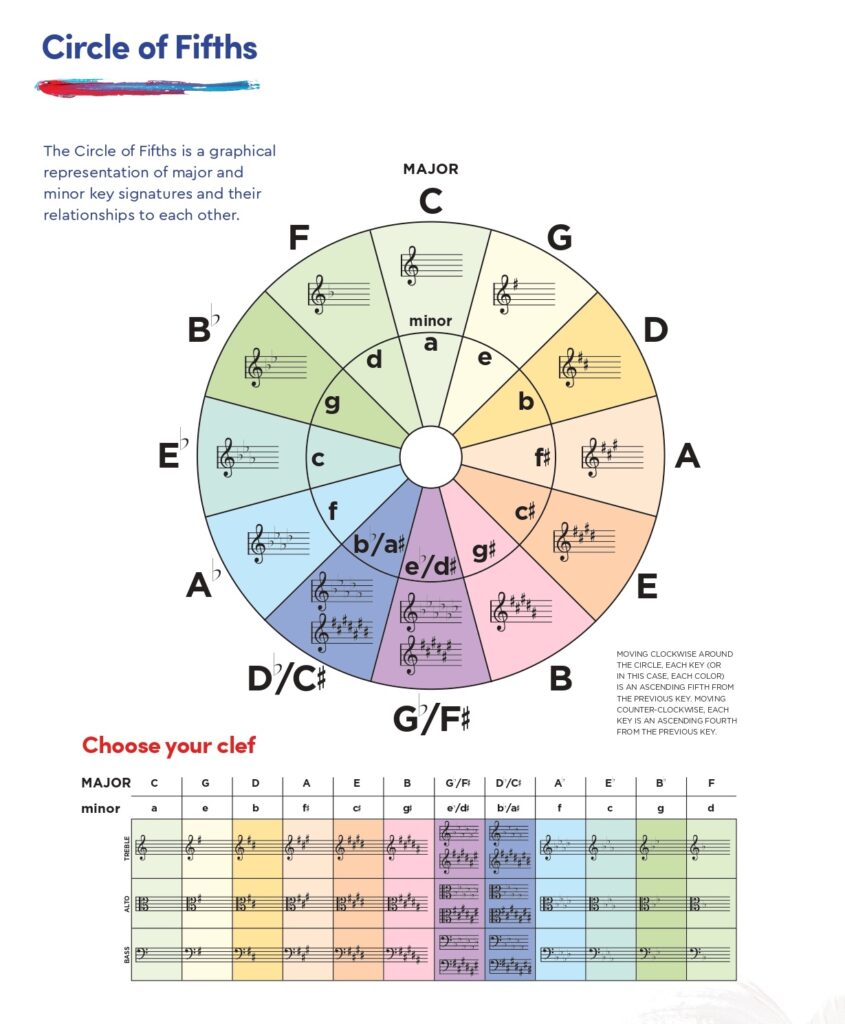The circle of fifths is one of the most fundamental and important concepts in music theory. It’s a visual representation of the relationships between different notes and chords, and it can be used to generate an endless supply of chord progressions. For guitarists, the circle of fifths is an invaluable tool for understanding how chords are connected and how to create interesting and unique progressions.
What is the circle of fifths?
The circle of fifths is a diagram that shows the 12 major keys arranged in a circle. Each key is connected to its neighbors by a fifth interval, which is the distance between two notes that are five scale positions apart. For example, the fifth interval from C is G, and the fifth interval from G is D.
How to use the circle of fifths for guitar chord progressions
There are many ways to use the circle of fifths to create guitar chord progressions. Here are a few ideas:
- Move around the circle clockwise or counterclockwise. This will give you progressions that have a sense of movement and direction. For example, moving clockwise from C major, you would get C major, G major, D major, A major, E major, B major, F# major, and C# major. This is a classic “I-V-vi-IV” progression that is used in countless songs.
- Use adjacent chords. Chords that are next to each other on the circle of fifths tend to sound good together. For example, C major and G major sound good together because they share two notes (C and G). Similarly, G major and D major sound good together because they share two notes (G and D).
- Use opposite chords. Chords that are directly opposite each other on the circle of fifths tend to create a sense of tension and release. For example, C major and F major are opposite each other on the circle. Playing them together creates a dissonant sound that can be resolved by moving to either G major or A minor.
- Experiment with different chord types. The circle of fifths can be used with any type of chord, not just major chords. Try using minor chords, seventh chords, and even suspended chords to create more complex and interesting progressions.
Chart
Here is a chart that shows the circle of fifths with the major and minor chords for each key:


Tips
- Don’t be afraid to experiment! The circle of fifths is a tool, not a rulebook. There are no wrong answers when it comes to creating chord progressions.
- Listen to your favorite songs and try to identify the chord progressions that are being used. This is a great way to learn how to use the circle of fifths in your own music.
- There are many online resources that can help you learn more about the circle of fifths and how to use it to create guitar chord progressions.
I hope this blog post has helped you to understand the circle of fifths and how you can use it to create your own guitar chord progressions. With a little practice, you’ll be able to unlock a world of creative possibilities!
Please note that this is just a basic overview of the circle of fifths. There is much more to learn about this fascinating topic. I encourage you to do your own research and explore the many ways that the circle of fifths can be used to create music
How to memorize the circle of fifths
Sharps: Remember “FACE” (F-C-G-D-A-E) for the order of sharps, then “Always Up a Fifth” – each sharp key is a fifth up from the previous.
Flats: Remember “Going Down, Brown” (Gb-Db-Ab-Eb-Bb) for the order of flats, then “Every Other Fifth” – each flat key is two flats after the previous.
Bonus: Practice playing chords or scales in fifths up and down the circle.
This should get you started on memorizing the circle of fifths!
Would the Circle of Fifths be of any use to a beginning .
Absolutely! The Circle of Fifths is a powerful tool for beginners, especially guitarists, to:
Visualize the relationships between chords: It’s like a map of musical connections, showing how chords “talk” to each other.
Learn key signatures: Starting from C major (no sharps or flats), you can see how each key adds sharps or flats as you move clockwise.
Create chord progressions: Explore countless possibilities by moving around the circle, using adjacent or opposite chords, or jumping by fifths.
Imagine it as a cheat sheet for understanding and building chords, making music creation more intuitive and enjoyable.
So, yes, the Circle of Fifths is definitely worth exploring for a beginning musician. It’s like having a secret decoder ring for unlocking the mysteries of harmony!
How do you apply the circle of fifths rules (chords …
Move around the circle:
Clockwise: Smooth, “going home” feeling (I-V-vi-IV progressions).
Counterclockwise: More tension and movement.
Skip a beat: Surprise! Use opposite chords for dramatic tension-release.
Adjacent chords: Usually sound good together, sharing 2 notes.
Experiment! Cof5ths is a guide, not a rulebook. Mix major/minor, add sevenths, have fun!
Bonus: Use the Cof5ths to find “sister chords” (next to your root) and “cousin chords” (across the circle) for unexpected harmonies.
Remember, the Cof5ths is a tool to explore and create, not a memorization test. Enjoy the journey!


2 thoughts on “Circle of Fifths Guitar Chord Progressions: Your Key to Unlocking Creativity”